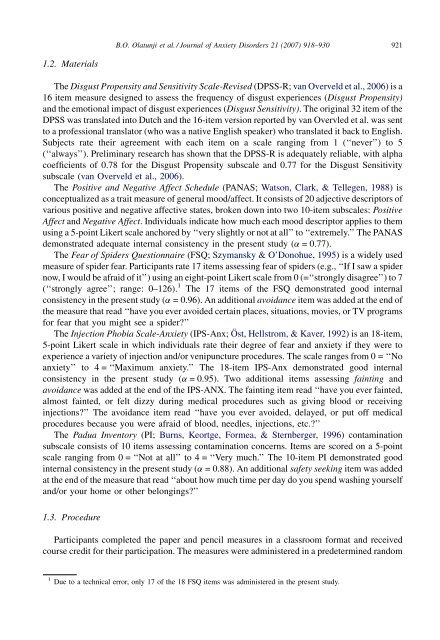The Disgust Propensity and Sensitivity Scale-Revised - University of ...
The Disgust Propensity and Sensitivity Scale-Revised - University of ...
The Disgust Propensity and Sensitivity Scale-Revised - University of ...
- No tags were found...
Create successful ePaper yourself
Turn your PDF publications into a flip-book with our unique Google optimized e-Paper software.
B.O. Olatunji et al. / Journal <strong>of</strong> Anxiety Disorders 21 (2007) 918–930 9211.2. Materials<strong>The</strong> <strong>Disgust</strong> <strong>Propensity</strong> <strong>and</strong> <strong>Sensitivity</strong> <strong>Scale</strong>-<strong>Revised</strong> (DPSS-R; van Overveld et al., 2006)isa16 item measure designed to assess the frequency <strong>of</strong> disgust experiences (<strong>Disgust</strong> <strong>Propensity</strong>)<strong>and</strong> the emotional impact <strong>of</strong> disgust experiences (<strong>Disgust</strong> <strong>Sensitivity</strong>). <strong>The</strong> original 32 item <strong>of</strong> theDPSS was translated into Dutch <strong>and</strong> the 16-item version reported by van Overvled et al. was sentto a pr<strong>of</strong>essional translator (who was a native English speaker) who translated it back to English.Subjects rate their agreement with each item on a scale ranging from 1 (‘‘never’’) to 5(‘‘always’’). Preliminary research has shown that the DPSS-R is adequately reliable, with alphacoefficients <strong>of</strong> 0.78 for the <strong>Disgust</strong> <strong>Propensity</strong> subscale <strong>and</strong> 0.77 for the <strong>Disgust</strong> <strong>Sensitivity</strong>subscale (van Overveld et al., 2006).<strong>The</strong> Positive <strong>and</strong> Negative Affect Schedule (PANAS; Watson, Clark, & Tellegen, 1988) isconceptualized as a trait measure <strong>of</strong> general mood/affect. It consists <strong>of</strong> 20 adjective descriptors <strong>of</strong>various positive <strong>and</strong> negative affective states, broken down into two 10-item subscales: PositiveAffect <strong>and</strong> Negative Affect. Individuals indicate how much each mood descriptor applies to themusing a 5-point Likert scale anchored by ‘‘very slightly or not at all’’ to ‘‘extremely.’’ <strong>The</strong> PANASdemonstrated adequate internal consistency in the present study (a = 0.77).<strong>The</strong> Fear <strong>of</strong> Spiders Questionnaire (FSQ; Szymansky & O’Donohue, 1995) is a widely usedmeasure <strong>of</strong> spider fear. Participants rate 17 items assessing fear <strong>of</strong> spiders (e.g., ‘‘If I saw a spidernow, I would be afraid <strong>of</strong> it’’) using an eight-point Likert scale from 0 (=‘‘strongly disagree’’) to 7(‘‘strongly agree’’; range: 0–126). 1 <strong>The</strong> 17 items <strong>of</strong> the FSQ demonstrated good internalconsistency in the present study (a = 0.96). An additional avoidance item was added at the end <strong>of</strong>the measure that read ‘‘have you ever avoided certain places, situations, movies, or TV programsfor fear that you might see a spider?’’<strong>The</strong> Injection Phobia <strong>Scale</strong>-Anxiety (IPS-Anx; Öst, Hellstrom, & Kaver, 1992) is an 18-item,5-point Likert scale in which individuals rate their degree <strong>of</strong> fear <strong>and</strong> anxiety if they were toexperience a variety <strong>of</strong> injection <strong>and</strong>/or venipuncture procedures. <strong>The</strong> scale ranges from 0 = ‘‘Noanxiety’’ to 4 = ‘‘Maximum anxiety.’’ <strong>The</strong> 18-item IPS-Anx demonstrated good internalconsistency in the present study (a = 0.95). Two additional items assessing fainting <strong>and</strong>avoidance was added at the end <strong>of</strong> the IPS-ANX. <strong>The</strong> fainting item read ‘‘have you ever fainted,almost fainted, or felt dizzy during medical procedures such as giving blood or receivinginjections?’’ <strong>The</strong> avoidance item read ‘‘have you ever avoided, delayed, or put <strong>of</strong>f medicalprocedures because you were afraid <strong>of</strong> blood, needles, injections, etc.?’’<strong>The</strong> Padua Inventory (PI; Burns, Keortge, Formea, & Sternberger, 1996) contaminationsubscale consists <strong>of</strong> 10 items assessing contamination concerns. Items are scored on a 5-pointscale ranging from 0 = ‘‘Not at all’’ to 4 = ‘‘Very much.’’ <strong>The</strong> 10-item PI demonstrated goodinternal consistency in the present study (a = 0.88). An additional safety seeking item was addedat the end <strong>of</strong> the measure that read ‘‘about how much time per day do you spend washing yourself<strong>and</strong>/or your home or other belongings?’’1.3. ProcedureParticipants completed the paper <strong>and</strong> pencil measures in a classroom format <strong>and</strong> receivedcourse credit for their participation. <strong>The</strong> measures were administered in a predetermined r<strong>and</strong>om1 Due to a technical error, only 17 <strong>of</strong> the 18 FSQ items was administered in the present study.




